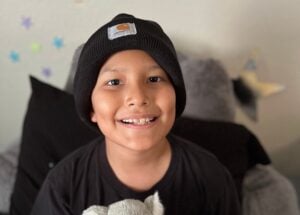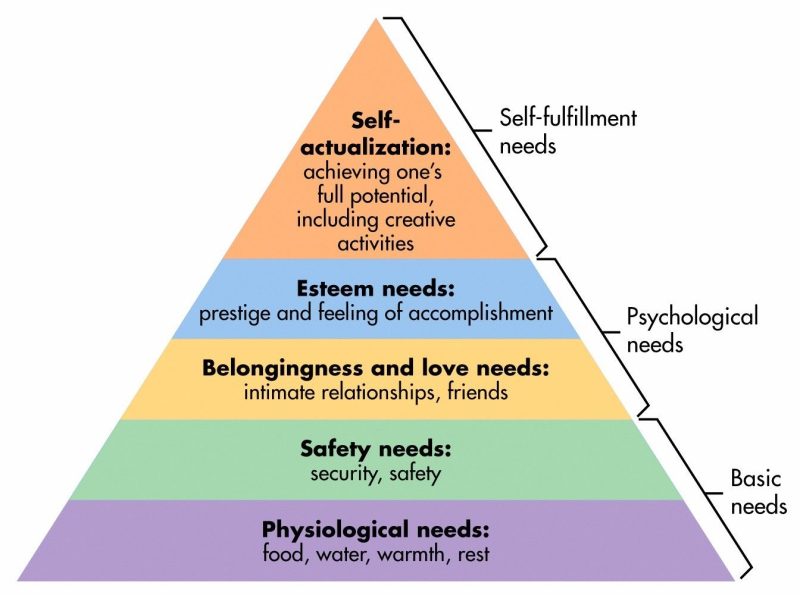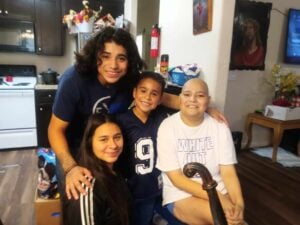
Sights Set on a Strong End to 2023 — Will You Join Us?
Family Reach CEO Carla Tardif reflects on 2023 and calls for community support before the year ends.
Financial toxicity discussions spotlight the financial burden of cancer, but many fail to illuminate the heartbreaking impact this can have on cancer outcomes.
The other morning, I turned on NPR while getting my daughters ready for the day ahead. It was a Saturday, and like many of us on a weekend morning, I was doing my best to think about anything but work. Then Scott Simon’s familiar voice cited a statistic that underscored why I do what I do.
“About 1 in 4 people with cancer declare bankruptcy or lose their home to eviction or foreclosure.”1
The story featured Jeni, a mother and foster parent in South Dakota, who was diagnosed with breast cancer two years ago. Following her diagnosis came the layers that we at Family Reach know all too well: insurance doesn’t cover as much as you think, and debt piles up as tests, surgeries, treatments, and follow-ups require time off work and interrupt income.
Suddenly, you’re making unexpected trade-offs. For Jeni, “any money spent on medical bills could mean taking a child out of violin lessons or buying cheaper, less nutritious foods for her family.”
The story beautifully highlighted the financial devastation caused by a cancer diagnosis, but one key area was left unaddressed: the impact this has on a patient’s chances of survival.
Science has come so far, and new cures are emerging every day. But how effective is a new treatment if a parent skips their medication to put food on the table?
Financial devastation — what researchers call “financial toxicity” — is a hallmark of the American healthcare system. According to recent studies, one in three families can’t afford their basic needs during cancer treatment.2
This is more than just a sad reality of cancer — it’s taking the lives of mothers and fathers, sisters, and brothers across the country. Cancer patients who file for bankruptcy have a 79% greater risk of early mortality.3
Yet despite harrowing statistics like this, it’s currently up to individuals to borrow money, start a GoFundMe, and lean on nonprofits like Family Reach to ensure they can access treatment and keep their homes intact. That isn’t a sustainable solution to a crisis that impacts up to three-quarters of cancer patients each year.4
We hear leaders at the ASCO Annual Conference and White House Cancer Moonshot forums talk at length about the financial crisis of cancer, yet the narratives often position insurance policies and the high cost of treatment as the root cause of financial toxicity. By focusing the national conversation on these complex issues, we are collectively failing to address the critical non-medical side of the discussion.
People need secure housing, food, and transportation in order to adhere to treatment and improve their cancer outcomes.
Food insecurity in particular is a harrowing reality faced by people living with cancer. Even without a cancer diagnosis, food insecurity is well documented as a social determinant of health that influences poorer health outcomes. When cancer enters the picture, people with food insecurity are less likely to complete treatment.5 Nationally, 10.5% of Americans are food insecure.6 Research shows that among cancer patients, this jumps to anywhere from 39 to 61%.7
In his article, Transforming Practices Through the Oncology Care Model: Financial Toxicity and Counseling, Dan Sherman, Founder and President of The NaVectis Group, writes, “From a psychosocial standpoint, Maslow’s theory of the hierarchy of needs plainly established that if a person’s basic needs and his or her sense of security is threatened, the person will likely be unable to experience wellness.”

Would comprehensive insurance policies and lower drug costs help with the financial toxicity of cancer? Yes, but that alone won’t solve the problem.
Approximately 64% of the families we supported in 2021 lost half or more of their income once treatment began. For them, new medical bills are just one barrier to treatment adherence — everyday bills like car payments, rent, and groceries become a trade-off. For a majority (61%) of the families we serve, transportation is their greatest area of need, followed by housing (54%) and food (54%).
We won’t equitably reduce cancer deaths in the U.S. until families facing this disease are supported from all sides — medically, psychologically, and financially. More than ensuring medical costs are covered, this means creating a safe space for families to put up their hands and say, “I can’t feed my children” and then helping them right away.
As I reflected on Jeni’s story and other patient voices that Saturday morning, I was reminded of the simple and painful truth that people with cancer are losing it all.
Jeni’s story is not an anomaly. It is one of the hundreds of thousands that underscore the work we do at Family Reach. We aren’t alone in this knowledge, and stakeholders across the healthcare spectrum are developing and evaluating solutions. In 2020, researchers from Levine Cancer Institute published a study proving that financial interventions increased a patient’s chance of survival.8
Our research efforts going forward will focus on expanding that body of literature to demonstrate the undeniable link between financial health, basic needs, and cancer outcomes. Through our collaborations with healthcare professionals, researchers, corporate partners, and other nonprofits, we’re working for a future where financial treatment is a standard of cancer care.
Together, we can improve cancer survival rates. The data proves it.
Resources

As COO at Family Reach, Rosie plays a pivotal role in the progression of the organization’s services, research, and collaborations. She launched the inaugural strategic planning process in 2019 and works closely with the team to ensure that all internal and external activity is aligned to push the mission forwards.

Family Reach CEO Carla Tardif reflects on 2023 and calls for community support before the year ends.

Your holiday giving provides financial relief to families like these who are facing cancer this winter.

Curious what a donation to Family Reach does? Here’s a breakdown of how donations to Family Reach provide financial support to families facing cancer.
Applications will only be reviewed and processed for open funds.
Applications will only be reviewed and processed for open funds.
Applications will only be reviewed and processed for open funds.
Applications will only be reviewed and processed for open funds.
Applications will only be reviewed and processed for open funds.
Join our email list for updates about our events, fundraising campaigns, family stories, partnerships, and the impact of your generous support.